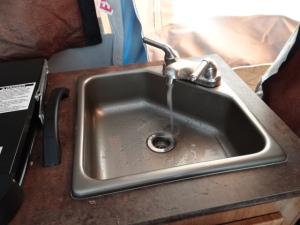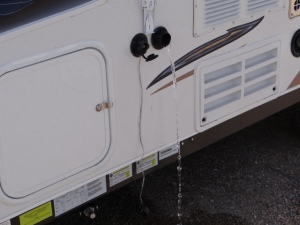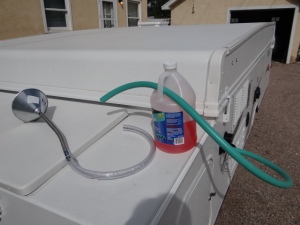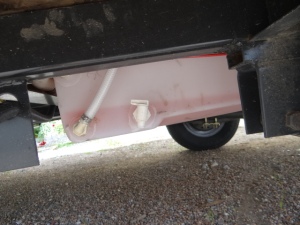“I know of no more encouraging fact than the unquestionable ability of man to elevate his life by a conscious endeavor.” Henry David Thoreau
My brain is muddled by a cold but I must share my recent accomplishment.
The weather forecast calls for up to 10 inches of snow by Friday evening. I don’t believe a word of it; last year on the exact same day, we had the exact same forecast, and we received only a light frosting of snow. However, I am taking the accompanying low temperature forecasts seriously. We had near freezing last week, but tonight we expect 29 degrees or less. The water lines in my camper, Half Moon, would likely burst if I do not winterize. I have been thinking about this for a few weeks, and while in Denver lazing around I watched some U-tube videos about draining my water supply and adding the “non-toxic” RV antifreeze.
The steps involved: drain water tank, add a few gallons anti-freeze, turn on water pump, run through system. Sounds easy but it took three trips to the hardware store to get a funnel with a long enough end. I also had to add some plastic tubing to the end so I could wiggle the funnel down deep (otherwise it back-flowed out).
I also needed to add some antifreeze to the second water intake (for use with pressurized city water). That intake has a screen filter across the opening (preventing me from inserting the funnel), so I had to cut a garden hose, screw it onto the intake and pour some antifreeze down the hose. I was hesitant to cut a perfectly good garden hose, but when I compared the cost of a hose vs. the cost of a broken water line, I made the cut. I got a little bit of antifreeze in there.

Step One: drain fresh water holding tank, after I drained through the sink, I found a drain plug on the water tank!

Part of Step One: water from sink drains out this port

Step Two: Potable water tank “antifreeze”

Funnel, hose

Fresh water tank with pink stuff in it, which was also pumped up through sink. Notice nice drain plug that I missed before
I did it! I did it myself. Before coming to Wheatland I would have schlepped Half Moon to the dealer and paid someone else to do the winterizing. Truthfully, for anything that needed done, I picked up the phone and called a specialist. For this project, I found water line schematics online, watched the U-tube videos, read pop-up camper forums, bought the antifreeze, rigged up funnels and got the job done. I feel like a peacock strutting around today.
I am inspired by the people here, in my rural community. The first winter after I arrived , I overheard a man talking about being his own chimney sweep. He simply set a long ladder up against the chimney and stirred a fat metal chain around inside to knock off the soot. I also watched ranchers vaccinate and castrate their calves without a veterinarian present and fix all their equipment without official mechanics. That first summer, I heard the ladies talking about canning, freezing, and pickling their produce. Later, I watched a rancher friend fix fences and irrigation rigs. The only time I observed him calling in outside help was to poison the prairie dogs who took over his north pasture. This appalled me, but I work hard not to lecture people who make a living off the land. Things are complicated.
Women homesteaders of the early 1900s also inspired me. I read stories about young women who longed for the adventure of the west every bit as much as young men. Teachers, for example, could make a living in a 1-room schoolhouse while staking a homesteading claim. The closest neighbor could be 10 miles or more away and so these women learned to many things. My favorite book was Staking Her Claim: Women Homesteading the West by Marcia Hensley, although you can find many others by searching Amazon for “women homesteaders”.
My most successful attempt at self-sufficiency is my large garden. I haul in manure from the county fairgrounds in 5 gallon buckets. Each year the garden grows larger, so I haul increasingly more manure, sometimes up to 50 trips over the year (9 buckets at a time). The garden produce once again fills my used freezers and have stores of onions and winter squash. I also learned to pickle, although the first year the result was not especially delicious (sugar in dill pickles?). I trade winter squash and other vegetables for plenty of wild game and sometimes for eggs as well. If I was not afraid of guns I might consider hunting myself, but I am quite content with just tagging along with friends and then bartering for a share of the bounty.
Not long ago, children were raised to be self-sufficient. Around here, kids helped with all of the farm and ranch work and gained their skills from parents and grandparents.
However, self-sufficiency in modern times is a matter of choice. I do not have to produce my own food, but I choose to eat healthier and cleaner vegetables. I do not have to grow flowers when I can get some at the store, but my homegrown bouquets bring me great joy. I do not have to winterize my camper, but I choose save money and learn how to care for myself. I do not have to crochet blankets and sew some of my clothes, but I enjoy the creativity during the cold and windy winter months. I do not have to use essential oils and homeopathic remedies for minor injuries, aches and pains, but I take delight in some simple self-doctoring, where appropriate. And there is so much more that I can learn to do.
So in middle-class America, self-sufficiency has gone from “must do” to “choose to do.” And there are good reasons to make the choice where possible: the feeling of satisfaction is liberating, the physical and mental exercise involved improves health and keeps the mind strong, the money saved can be channeled elsewhere, the creativity keeps us alive and allows us to regain some balance and perspective about consumerism.
“Most of the luxuries and many of the so-called comforts of life are not only indispensable but positive hindrances to the elevation of mankind. Henry David Thoreau.
It is interesting to consider that self-sufficiency may become a necessity again, especially as our resources dwindle and our environment suffers. Further, no one knows with certainty where our politicians are leading us, but it could be that we must learn to do more for ourselves if our economy stumbles ever further downward. I consider my time in a rural community of self-sufficient people to be great training for an uncertain future.

Produce (Photo credit: La Grande Farmers’ Market)
Related articles
- On Henry David Thoreau and “Eat the Donuts” (readingbyeugene.com)
- Henry David Thoreau – Famous Quotes (socialgusto.wordpress.com)
Jane, I’m discovering your blog and enjoying it. I agree wholeheartedly with you about self sufficiency and how satisfying it is to be self-reliant.
I was forced into doing things because I had to. There was no one else to do it for me. I really resented it at first. But once I started actually being able to do things that I once relied on others to do, I feel such a sense of accomplishment.
Congratulations on learning to winterize your own camper! :)
Thanks for the compliments. I was also forced into doing things and did not like it. Funny how a perceived weakness becomes a strength over time.